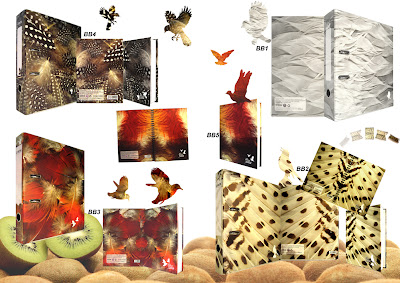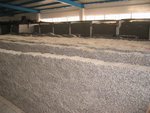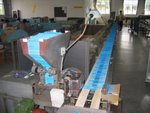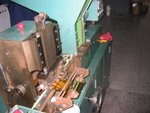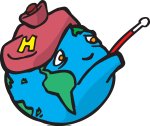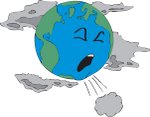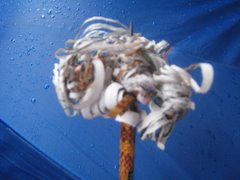Thursday, November 29, 2007
Tuesday, November 27, 2007
Wednesday, October 10, 2007
Big Announcement - O'BONanza
Yes, O'BON has a new design. Photos of these pencils will be up next week. But, John and Ivan think these pencils will be as big a hit as the Wildlife pencils. As you may know, O'BON wildlife pencils are incredibly popular, so to have another rival design is quite an accomplishment. So, you guys who love our designs, check back next week and you can feast your eyes on our latest offering.
The packaging again in award winning. This time, we go cube. 9, 2B pencils tucked nicely in the cube box. Cute. Come back next week.
The packaging again in award winning. This time, we go cube. 9, 2B pencils tucked nicely in the cube box. Cute. Come back next week.
Saturday, September 22, 2007
Monday, September 17, 2007
Sunday, September 16, 2007
Ripped off by US Government

O'BON LLC recently imported its first container of pencils into the USA. They had to pay 114% duty on the recycled pencils. This is to stop "dumping." The money paid to customs for "dumping" goes directly to support the pencil industry in the USA. This would all be understandable if "dumping" was involved and, more importantly, there was a recycled pencil industry effected by the "dumping." Bare with me on my logic.
O'BON imports recycled newspaper pencils and the 114% tax goes to support the USA wood pencil industry. Excuse me, where is the logic in this? Cutting down trees to make pencils, to us, is a bad use of our limited resources and the wood cutting industry plays a big part in global warming through deforestation. Wood pencils are part of this problem. So, for O'BON to simply give this money to wood pencil manufacturers seems unfair and unjust. Our concept, technology and innovation supports an old, outdated and global warming industry. The energy consumed and the footprint size of wood pencil manufacturers is big. Frankly, O'BON is appalled and seeks any advice out of this situation. Giving our money to wood pencil manufacturers is painful for us.
If our money went to the recycled newspaper pencil business in the USA, this would be tolerable, but to support wood cutting and deforestation is beyond acceptable. Any ideas?
Wednesday, July 25, 2007
O'BONanaza is coming soon. A whole series of beautiful fruit notebooks, memo pads, file folders, spiral notebooks and 3 ring binders all matching and celebrating the introduction of our O'BONanza 2B fruit pencils. These recycled pencils are just (as my daughter says) "too cute."
The idea behind these recycled products are to celebrate "life." When we taste an apple, a strawberry or a kiwi a splash of unequal flavor and taste explodes. Wow! And these fruits are so good for us. We celebrate their beauty and the antioxidants (and health) they generate. We have a total of 9 fruit pencils and lots of notebooks. The art is fantastic - take a look at the dew on the apple.
Saturday, July 21, 2007
Wednesday, July 18, 2007
O'BON lasts longer!
For over 400 years, wood pencil makers have taken graphite and surrounded it in a wood casing. There is almost always an air gap between the two pieces of wood. Drop the pencil, there is vibration. This vibration snaps the brittle graphite. Bang an OBON pencil on your desk, then sharpen it. No breakage. OBON pencils will usually last you 3 times longer.
Sunday, July 15, 2007
O'BON introduces more products
 O'BON will be introducing a whole new line of office stationery. These will include memo pads, notebooks, file folders, spiral notebooks (3 sizes) and 3 ring binders. All will be made from recycled paper, recycled newspaper, water-based glue and vegetable ink. Oh, and are they beautiful as we continue to follow our slogan, "Something Different."
O'BON will be introducing a whole new line of office stationery. These will include memo pads, notebooks, file folders, spiral notebooks (3 sizes) and 3 ring binders. All will be made from recycled paper, recycled newspaper, water-based glue and vegetable ink. Oh, and are they beautiful as we continue to follow our slogan, "Something Different."Tuesday, June 12, 2007
Saturday, June 9, 2007
Why O'BON pencils are round?

The real question to us is why aren't all pencils round. We have been trying to research this question and would like comments on our hypothesis. First, our pencils are round because that is the best way to make them. We use the exclusive "roll-on" method. Why sand them into hexagonal or triangular shapes? Do they fit the hand better? No, not really. What the hexagonal shape does is prevent the pencil from rolling off the table or desk. This is bad for wood pencils because the graphite easily snaps. But, O'BON don't (very rare event) break. Drop them, step on them, put them under dad's car tire - they won't break. In another writing I'll explain why. So, at O'BON we don't worry about the pencil graphite snapping as it just won't happen.
But wood pencils are different. They break easily. One little drop from the desk to the floor and your pencil graphite can snap 3 times inside the pencil. So, when you sharpen, the graphite comes out and you have to sharpen some more. No fun.
The interesting part of our research is that the hexagonal shape came into being in the late 1800s. The round pencil manufacturers discovered that in the slat of wood that they would grind the groove for the graphite, if they chose the hexagonal shape, then they could make 9 pencils from one slat of wood. Before, with the small length of slat, they could only make 8. So, hexagonal became the preferred shape - and the shape of most pencils today. Any comments on our opinion backed up with some limited research? We want to know why they are hexagonal? Let's solve this riddle.
Say "No" to Wood Pencils

O'BON has launched a new Google Ad with Adwords that is a little aggressive: Say "No to Wood Pencils." When you consider that 18 billion wood pencils are being made every year, you can get an idea of how many trees would be involved with this. Alot of people think that sustainable forests solve this problem, but they don't! At the pace we continue to destroy primary jungle and forests to create these "sustainable" forest, you can see the problem. We started this campaign theme as
 so few people actually know there is such a thing as a recycled pencil. And the big pencil gaints spend a lot of money trying to convince us that wood pencils are ok as they come from sustainable forests. Well, excuse me - we beg to differ. Sustainable forests have extremely limited diversity. How many cute tree frogs live in a sustainable forest?
so few people actually know there is such a thing as a recycled pencil. And the big pencil gaints spend a lot of money trying to convince us that wood pencils are ok as they come from sustainable forests. Well, excuse me - we beg to differ. Sustainable forests have extremely limited diversity. How many cute tree frogs live in a sustainable forest?So, we have up the rhetoric with our Say "No" to wood pencils.
Saturday, June 2, 2007
Buy on Line

O'BON products (pencils, pens, file folders, erasers, art pencils, etc) can be now purchased on line. We are excited about opening this avenue of selling our recycled products as we can deal directly with our customers. Click on www.school-obon.com and see our products.
Monday, February 12, 2007
Ivan Hoo, Director of O'BON International

Ivan Hoo is a Director of O'BON International. Born in Singapore, Ivan is a man of the world. Name a country and he has probably been there. His claim to fame is marketing...and he is a marketing genius. He specializes in creating new products and bring them to the market place.
Currently he lives most of the time in China as he is responsible for developing, manufacturing and maintaining quality control of O'BON products.
He lives in Guangzhou with his lovely wife, Sharon. They have three girls - all so cute!
John W. Davis, Director of O'BON International

John W. Davis
O'BON International is a hoot. We have such a great time trying to develop great recycled products which bedazzle. Without a doubt, we produce "the world's greatest pencil." But now we offer so much more - erasers, pens, filefolders and art pencils. Check it all out at www.obon.us
Besides our interest in developing great recycled products, we are adamant about engaging our customers and creating dialogue about our serious 21st century environmental issues.
This is the place to scream, big scream. Let us know what you think....
Did you know?
Did You Know?
Texans dump enough trash every two weeks to fill the Astrodome.
The 19.2 million tons of Texas municipal solid waste would fill two lanes of IH-10 from Beaumont to El Paso 10 feet high.
The number of cities offering some type of recycling or composting service grew 500% from 40 in 1990 to 250 in 1996.
In the U.S., eight out of ten people are willing to separate household trash for recycling.
The recycling industry accounts for more than 20,000 private-sector jobs in Texas in the processing and end-market facilities adding $2.8 billion to the Texas economy annually.
Recycling waste materials supports about six times as many waste-related jobs as there would be if the same materials were treated as trash.
Glass Recycling Facts
U.S. consumers discard enough glass to fill the 1,350 foot twin towers of New York's World Trade Center every two weeks.
These same consumers recycle approximately 1.25 million tonsof glass annually.
Recycling Facts
Throughout a year, at least 20% of solid waste by Texans comes from grass clippings, tree leaves and other landscape waste.
Yard debris accounts for approximately 31 million tonsof the nation's municipal solid waste.
Aluminum Recycling Facts
American consumers and industry throw away enough aluminum in a year to rebuild our entire airplane commercial fleet every three months.
However, a record 56.85 billion aluminum beverage cans were recycled in the U.S. during 1991 — about 227 cans for every person in the nation.
Recycling one aluminum can saves enough electricity to power a TV or a 100-watt light bulb for three hours.
In 1997, the Recycling Division of the City of Houston Department of Solid Waste Management recycled 20 tons of aluminum cans.
Paper Recycling Facts
The production of a ton of paper requires 17 trees, 7,000 gallons of water and more energy per ton than glass or steel.
Americans dump 180 million tons of garbage annually — more than 40% of which is paper. High-grade printing, copying and writing paper is the largest single component in a landfill.
Every year Americans use more than 67 million tons of paper or 580 pounds per person.
Americans throw away enough office and writing paper annually to build a wall 12 feet high stretching from Los Angeles to New York.
Also, every day American businesses generate enough paper to circle the Earth 20 times.
In addition, every year each American household receives an average of 1.5 tree's growth of bulk mail advertising — commonly known as "junk mail."
In 1997, the Recycling Division of the City of Houston Department of Solid Waste Management recycled 13,600 tons of paper.
Recycling 13,600 tons of paper accounts for the saving of 231,200 trees, 44,880 cubic yards of landfill space and 95,200,000 million gallons of water.
Household Hazardous Waste Facts
The average American household generates 15 pounds of hazardous waste a year. Most of it goes into landfills, sewage treatment plants and septic tanks.
An estimated 1.6 million tons of household hazardous waste exists in the municipal waste stream right now.
The average baby will use about 10,000 diapers before toilet training. An estimated 1 billion trees a year are required to produce disposable diapers.
The U.S. Postal Service delivered approximately 63 billion pieces of third-class mail in 1990. An estimated 5 million trees were used to produce all of 1990s third-class mail. An estimated 10 billion pieces of third-class mail were discarded without being opened.act
Texans dump enough trash every two weeks to fill the Astrodome.
The 19.2 million tons of Texas municipal solid waste would fill two lanes of IH-10 from Beaumont to El Paso 10 feet high.
The number of cities offering some type of recycling or composting service grew 500% from 40 in 1990 to 250 in 1996.
In the U.S., eight out of ten people are willing to separate household trash for recycling.
The recycling industry accounts for more than 20,000 private-sector jobs in Texas in the processing and end-market facilities adding $2.8 billion to the Texas economy annually.
Recycling waste materials supports about six times as many waste-related jobs as there would be if the same materials were treated as trash.
Glass Recycling Facts
U.S. consumers discard enough glass to fill the 1,350 foot twin towers of New York's World Trade Center every two weeks.
These same consumers recycle approximately 1.25 million tonsof glass annually.
Recycling Facts
Throughout a year, at least 20% of solid waste by Texans comes from grass clippings, tree leaves and other landscape waste.
Yard debris accounts for approximately 31 million tonsof the nation's municipal solid waste.
Aluminum Recycling Facts
American consumers and industry throw away enough aluminum in a year to rebuild our entire airplane commercial fleet every three months.
However, a record 56.85 billion aluminum beverage cans were recycled in the U.S. during 1991 — about 227 cans for every person in the nation.
Recycling one aluminum can saves enough electricity to power a TV or a 100-watt light bulb for three hours.
In 1997, the Recycling Division of the City of Houston Department of Solid Waste Management recycled 20 tons of aluminum cans.
Paper Recycling Facts
The production of a ton of paper requires 17 trees, 7,000 gallons of water and more energy per ton than glass or steel.
Americans dump 180 million tons of garbage annually — more than 40% of which is paper. High-grade printing, copying and writing paper is the largest single component in a landfill.
Every year Americans use more than 67 million tons of paper or 580 pounds per person.
Americans throw away enough office and writing paper annually to build a wall 12 feet high stretching from Los Angeles to New York.
Also, every day American businesses generate enough paper to circle the Earth 20 times.
In addition, every year each American household receives an average of 1.5 tree's growth of bulk mail advertising — commonly known as "junk mail."
In 1997, the Recycling Division of the City of Houston Department of Solid Waste Management recycled 13,600 tons of paper.
Recycling 13,600 tons of paper accounts for the saving of 231,200 trees, 44,880 cubic yards of landfill space and 95,200,000 million gallons of water.
Household Hazardous Waste Facts
The average American household generates 15 pounds of hazardous waste a year. Most of it goes into landfills, sewage treatment plants and septic tanks.
An estimated 1.6 million tons of household hazardous waste exists in the municipal waste stream right now.
The average baby will use about 10,000 diapers before toilet training. An estimated 1 billion trees a year are required to produce disposable diapers.
The U.S. Postal Service delivered approximately 63 billion pieces of third-class mail in 1990. An estimated 5 million trees were used to produce all of 1990s third-class mail. An estimated 10 billion pieces of third-class mail were discarded without being opened.act
Dear Friends,
Optimism about our planet’s future
Who could possible say that there is no global warming? Clearly the world is heating up from burning fossil fuels faster than anyone anticipated? Islands are now disappearing with the rising seas. Storms are fierce, and 2007 is scheduled to be the hottest year in recorded history. The wonderful polar bear is the latest to join the endangered species’ list. Who could possible say that the destruction of our environment is not taking place at a record pace? It clearly is. Who could possibly say our future as a planet is not threatened with extinction? Scientists now state this possibility. Worst still, our world is not in steady hands as it is being driven over the looming environmental cliff.
Even faced with this dangerous reality, we are optimistic. We believe more companies will become environmentally conscious and more customers will demand “non-harmful” products. Companies that pollute, produce toxic plastic, destroy forests or create landfills will suffer financially. Consumers will select companies that foster life, protect wildlife and natural resources and promote recycling. We see a tidal wave of change coming in how customers choose their products and how companies manufacture their goods. This trend gives us great hope.
We also are optimistic because of the children. Kids get it that this world is in a precarious state. They understand that we have to conserve our precious drinking water and protect our wildlife. It is natural for children to be environmentalists. We hope they grow up and save us all.
We ask you to join us in promoting the recycled message. Buying products which don’t harm our environment and supporting companies which produce recycled products are just two ways to help. Let your pocketbook help protect our tigers, lions, whales and polar bears. Changing your lifestyle to incorporate the 3 Rs (reduce, reuse and recycle), is an excellent and necessary step. Helping promote the 3 Rs in your community is another. We also ask you to have the awareness to actively join us in being optimistic about our future. Our optimism about our planet’s future can only be real if you and your friends commit yourself to recycling.
We have put together this information packet for you to learn more about O’BON and our products. By going to our website at www.obon.us, you’ll learn even more. We ask you for your support, let others know about our work and our products.
Thanks,
John Davis
Ivan Hoo
Optimism about our planet’s future
Who could possible say that there is no global warming? Clearly the world is heating up from burning fossil fuels faster than anyone anticipated? Islands are now disappearing with the rising seas. Storms are fierce, and 2007 is scheduled to be the hottest year in recorded history. The wonderful polar bear is the latest to join the endangered species’ list. Who could possible say that the destruction of our environment is not taking place at a record pace? It clearly is. Who could possibly say our future as a planet is not threatened with extinction? Scientists now state this possibility. Worst still, our world is not in steady hands as it is being driven over the looming environmental cliff.
Even faced with this dangerous reality, we are optimistic. We believe more companies will become environmentally conscious and more customers will demand “non-harmful” products. Companies that pollute, produce toxic plastic, destroy forests or create landfills will suffer financially. Consumers will select companies that foster life, protect wildlife and natural resources and promote recycling. We see a tidal wave of change coming in how customers choose their products and how companies manufacture their goods. This trend gives us great hope.
We also are optimistic because of the children. Kids get it that this world is in a precarious state. They understand that we have to conserve our precious drinking water and protect our wildlife. It is natural for children to be environmentalists. We hope they grow up and save us all.
We ask you to join us in promoting the recycled message. Buying products which don’t harm our environment and supporting companies which produce recycled products are just two ways to help. Let your pocketbook help protect our tigers, lions, whales and polar bears. Changing your lifestyle to incorporate the 3 Rs (reduce, reuse and recycle), is an excellent and necessary step. Helping promote the 3 Rs in your community is another. We also ask you to have the awareness to actively join us in being optimistic about our future. Our optimism about our planet’s future can only be real if you and your friends commit yourself to recycling.
We have put together this information packet for you to learn more about O’BON and our products. By going to our website at www.obon.us, you’ll learn even more. We ask you for your support, let others know about our work and our products.
Thanks,
John Davis
Ivan Hoo
Subscribe to:
Posts (Atom)

